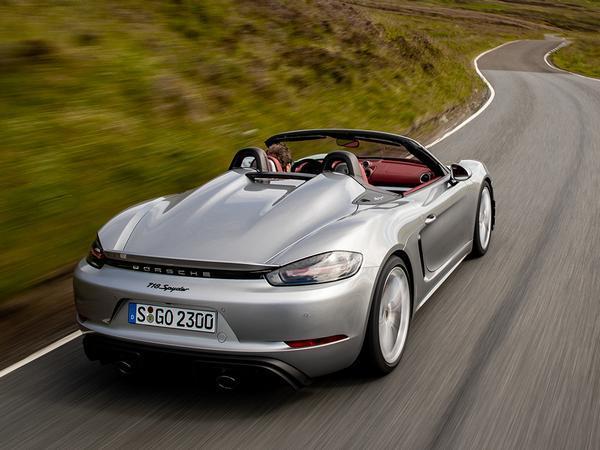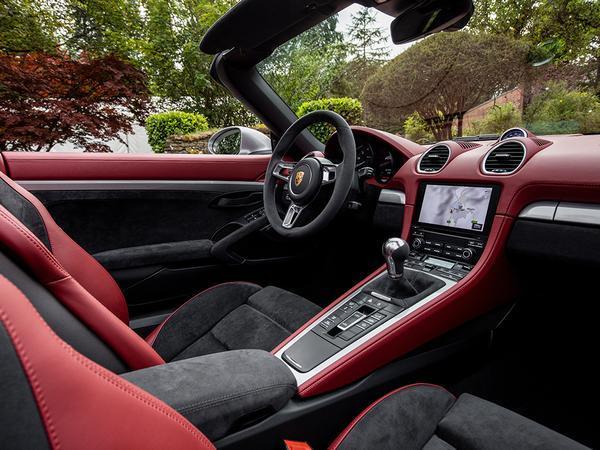2020 Porsche 718 Boxster Spyder | PH Review
Ding, ding - round two!

One person told me it looks like a grouper fish from the front, with its swollen lower lip. He might be right. But overall I think the Porsche 718 Boxster Spyder is hand-bitingly pretty. There is a toughness to it and a kind of visual drama that no Boxster has had before. The shapely rear deck gives it the presence of a supercar, never mind a sports car. It even looks good with its unusual hood in position and though I tend to prefer coupes to convertibles, I think on looks alone I'd pick the Spyder ahead of the new 718 Cayman GT4.
It is with that car that the Spyder shares not only its underpinnings, but also its suspension layout and settings, its engine, gearbox, differential and brakes. Apart from their lids - one removable, the other not - all that really separates the two models is a rear wing. The coupe has its fixed item, leaning high and hard into the airflow, and the roadster a deployable job that extends from the trailing edge of the rear deck at motorway speeds. Which means the Spyder's aerodynamic package generates a little less downforce. No, I'm not bothered either.
The launch event in Scotland gave us time on track in the GT4 and on the road in the Spyder, which is clearly the correct way round, though I can't say for certain what the droptop is like on the track, nor the coupe on the road. But I can take a pretty well-educated punt, because Porsche claims no weight advantage for either, no meaningful loss of torsional rigidity for the Spyder while mechanically, the two are identical. So the picture I've got in my mind of these Porsche Motorsport siblings looks pretty complete to me.

At rollicking Knockhill circuit I found the GT4 to be every bit as capable and exciting as the earlier model, albeit with what seemed like a slightly more rounded and less demanding nature. The GT4 had grown up a little without losing its sense of fun. And the sound that spat angrily from its twin exhaust pipes was agreeable enough, the new naturally-aspirated 4.0-litre flat-six apparently as rich in character as it was power.
But the soundtrack doesn't matter so much on circuit when you're concerned with more pressing things. So it was only when I drove the Spyder on the road, its roof firmly stowed away, that I realised something important. This new 420hp motor doesn't sing they way a high-revving n/a six should. It's muted. A touch flat even. Time and again I had to check the little button on the centre console to be sure the switchable exhaust really was in its noisier setting.
So what gives? To make a relatively high-capacity engine with no forced induction or electrical assistance emissions compliant - not only for today but the next few years as well - Porsche had no choice but to fit smothering gasoline particulate filters. Well, it did have a choice, but I don't imagine many of us would have been happier with a turbocharged four-pot. (This new power unit can also switch off one bank of cylinders at low engine speeds to reduce fuel consumption.) With those filters in position the engine is like a Naim home stereo rotated through 180-degrees to face the wall.

Just at the point you expect the exhaust note to harden and its pitch to rise, wind whipping through the open cabin and the smile on your face on the brink of widening, it instead runs coarse and harsh. It's kind of gutting, although I'm not sure there was a better alternative given the circumstances. I have no doubt the aftermarket tuning industry will be ready to step in.
The uninspiring soundtrack is a pity but the engine itself is a joy. There is scarcely a fraction of the ferocity and eyeball-rattling intensity of a 911 GT3 engine at full tilt, but the 9A2 Evo is muscular, and responsive, and full of energy, and it revs sweetly through the midrange and into the upper reaches and it pulls all the way to 8000rpm. It's a fine flat-six for today, if not the ages.
And it's strapped to one of the sweetest manual gearshifts you'll find anywhere, the Spyder's stubby little lever springing about its H-pattern gate with unerring precision. But the gear ratios. Oh the gear ratios. Like the Cayman, second will run on to 85mph, which means on a bouncing Scottish moorland it's the one you use most. That in itself isn't a problem, but should you ever slot third gear without running second gear all the way out, the engine drops out of its sweet spot. And if you run second gear all the way out, you're well beyond the national speed limit. In fact, the engine only really gets going at 5000rpm, at which point you're travelling at 55mph in second. So if you're observing the law of the land, you get to enjoy the motor at its best for all of a 5mph increase in velocity.

The cost of developing an entirely new set of ratios would apparently make the Spyder and Cayman GT4 far more expensive to buy, so maybe we should simply live with it. But I'm in no doubt: both would be more enjoyable to drive with shorter gearing.
The chassis, however, is pretty much beyond reproach. It does that magical Porsche Motorsport thing of mixing pliancy and fluency over a bumpy surface with resolute body control. While so many other sports cars seem to offer you one or the other, the Spyder shows you can have both at once. That makes it so enjoyable to fling along a quiet road, as do the pin-sharp steering, the consistent and predictable grip and the exquisite balance. The previous Boxster Spyder, itself not a not a Porsche Motorsport car, was a far more laid-back thing, perhaps more fluid and looser-limbed along a road but with far lower limits and slightly lazier responses.
This new model isn't all grip and no play, though. You can readily adjust its balance mid-corner and make it slide a little if you like, the torque vectoring mechanical LSD ensuring that whenever the rear axle does make a break for it, it always does so consistently. Becoming a more focused sort of sports car has not made the Boxster Spyder any less joyful.

Elsewhere you'll find a very good cabin with peerless infotainment and excellent build quality, a deep front storage compartment and a useful rear one, excellent standard brakes (carbon ceramics are optional but overkill unless you're a trackday addict), standard adaptive dampers that you'll only ever switch into the firmer mode on very smooth circuits and a somewhat fiddly roof.
The latter takes a minute or so to stow or close and it's almost entirely a manual process. Once you've committed the correct order to memory it's simple enough, but also far less convenient than the one-touch folding mechanism you'll find on a standard Boxster. The hood is also a single layer of fabric and nothing more, all of which suggests to me the Spyder is probably better suited to a sunnier climate than ours.
Not that you should let that stop you. This is a quite brilliant sports car, held back from perfection by a muted soundtrack and overlong gearing. At a little over £73,000 it's a couple of grand cheaper than the GT4 as well. The one to have? Unless you have no interest whatsoever in driving topless I'd say it is, given it gives nothing away in terms of performance or dynamic brilliance. As long as you don't mind driving a grouper fish.
SPECIFICATION - PORSCHE 718 BOXSTER SPYDER
Engine 3995cc, 6 cyls, n/a
Transmission Six-speed manual
Power 420hp @ 7600rpm
Torque 310lb ft @ 5000-6800rpm
0-62mph 4.4 secs
Top speed 189mph
Kerb weight 1420kg
MPG 25.9mpg
CO2 249g/km
Price £73,405
Inspired? Search for a Porsche 718 Boxster here











Gassing Station | General Gassing | Top of Page | What's New | My Stuff



